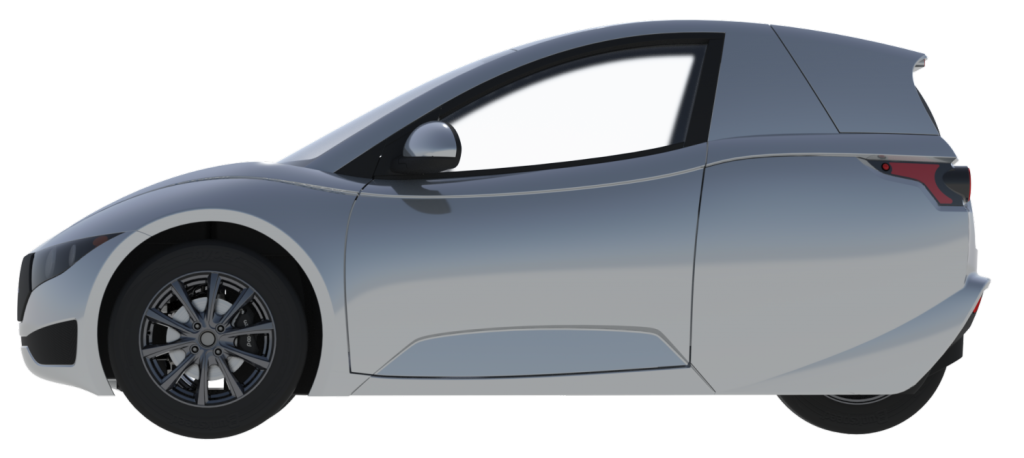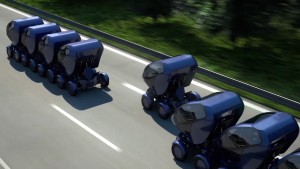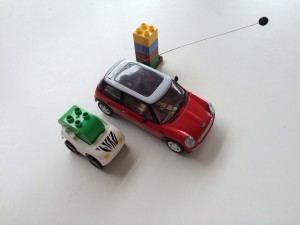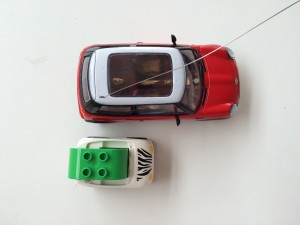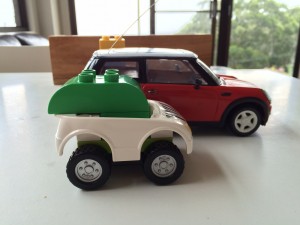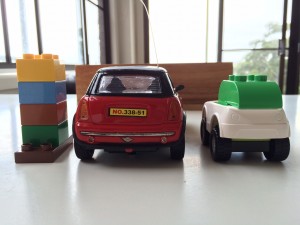Below are some of the cars I have used to inform my speculations on the size, shape and characteristics (performance and 'smart' technologies) of the Apple Car. I have also included the scale calculations for the models I used in my earlier piece. Together, this data informs my reasoning in the articles posted here and here.
Toyota i-Road Concept Car
Toyota has not released full specifications on this vehicle, but they have allowed several test drives mainly for the automotive media since the 2013 Geneva Motor Show.
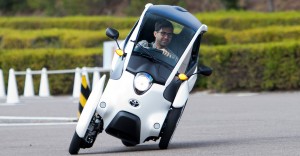
Development status: Working concept car
Length: 2,345 mm
Width: 870 mm
Height: 1,455 mm
Wheel base: 1,695 mm
Tire size: (Front)80/90-16 (Rear)120/90-10
Minimum turning radius: 3.0 m
Occupancy: Japan:1 Europe:2 *1
Curb weight: 300 kg *2
Powertrain: 2 electric motors
Maximum speed: Japan: 60km/h Europe: 45km/h *1
Cruising range on a single charge: 50 km*3
Battery type: Lithium-ion
- *1 In accordance with European regulations for vehicles in the i-Road's category
- *2 Vehicle weight without occupants or cargo
- *3 Target distance when traveling at a fixed speed of 30 km/h
Comments: The Toyota i-Road is the closest concept I have seen to what I think the Apple Car, or some other motorcar 'disruptor' will look like. It is primarily designed for solo transport (but fits 2 at a pinch - an adult passenger can tuck behind the driver with knees akimbo).
To make this product more 'accessible' and 'desirable' I imagine Apple will seek to improve the following:
- Appearance of safety: Although the i-Road already has an airbag in its steering wheel, perception matters. Perception of safety could be influenced perhaps by adding smoother curves and reinforcing around the side to bring it in line with nearly the thickness of a conventional car door - say 10cm.
- Convenience: A hidden issue with motorcycles, bicycles, electric bicycles, scooters etc is that they all require some degree of 'preparation' by the riders as well as on-going maintenance. By 'preparation' I mean, for example, putting on protective equipment such as helmet, protective riding leathers, high visibility clothing, locking (e.g. to a nearby pole, as bicycle stands are relatively few and far between), charging, turning on/off safety equipment e.g. flashing lights, helmet storage, strapping of cargo/luggage. By maintenance, motorcycles and bicycles require considerable maintenance relative to a car. Taken together, these issues form a 'sub-conscious' impediment to many prospective users of those modes of transport. A future micro-vehicle should be able to easily overcome these issues.
- Comfort (seating & ride): For a vehicle of this type to appeal to people of all ages and physical abilities, the seat would need to be softer and more 'plush' than the cheap, thin vinyl seats provided on the i-Road, though not as substantial and soft as a car seat. Some suspension would also be expected.
- Comfort (noise levels): Some effort will go into sound suppression, although making it too quiet will make this vehicle dangerous to pedestrians. Electric motors of the size used here tend to have a high-pitched whine which will be difficult to suppress in any case, although road noise could be reduced by more sound and temperature insulation.
- Comfort (protection from elements): Expect this to be high on an Apple Car's list. A major inhibitor to people using motorcycles, scooters and bicycles more often is the level of physical comfort and protection from the elements. To serve as a commuter vehicle, it must enable people to arrive at work without being sweaty, drenched, hot, cold or exhausted.
- Comfort (entertainment system, 'smart' technology): This is a given in a proposed Apple Car, considering Apple's known foray with CarPlay and Apple Maps. Ease of integration with Apple products and sophistication of smart technologies would be one of the key differentiators of an Apple Car to future competitors, such as the i-Road.
- Performance: For the vehicle to succeed in the First World markets, it would need to be more versatile than purely a 'last mile' commuter (e.g. to the shops and transport hub). Rather, the vehicle should be able to be used on the highway 'at a pinch'. Consequently, increasing top speed to 80-110km/h would be likely. It is likely these performance improvements will be possible considering the 6-10 year span between the i-Road's debut at the 2013 Geneva Motor Show and the Apple Car's earliest launch date.
- Price: No price has been provided by Toyota, but a price under $10,000 has been suggested. This would bring it in line with the critical threshold I believe it would need to achieve to provide a sufficient 'value proposition' in the mind of the consumer.
EO Smart Connecting Car 2

Technical Details
| Size: |
2.58 m x 1.57 m x 1.6 m; Or rather 1.81 m x 1.57 m x 2.25 m (The indication of the length of the vehicle depends on the type of tire / tyre section. The values have been recorded with tires of type 200/60 R 16 79V.) |
| Weight: |
750 kg |
| Power supply: |
54V – LiFePo4 battery |
| Speed: |
65 km/h (40 mph) |
| Actuation/ Engine: |
4 x 4kW wheelhub motors; 10 x longstroke-Lineardrive with 5000N 1 x Folding Servo |
| Sensors: |
Hall-effect as well as string potentiometer sensors for angle and length measurementStereo-Kameras at the front and at the back32-Line Lidar for 3D-scans of the environment6 ToF 3D cameras for near field overview |
| Communication: |
CAN-Bus RS232 RS485 LAN |
Comment: The EO Smart Connecting Car demonstrates (or at least conjectures) the types of technologies that would be important in solving important 'jobs to be done' e.g. parking and traffic (through it's convoying/platooning idea).
General Motors EN-V
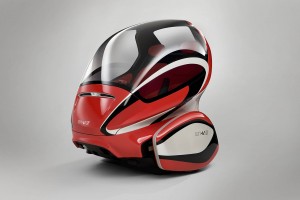
Specifications
Dimensions:
Jiao (Pride) 1,500 mm (L) x 1,425 mm (W) x 1,640 mm (H) [59” x 56” x 64.5”]
Xiao (Laugh) 1,540 mm (L) x 1,420 mm (W) x 1,770 mm (H) [60.5” x 56” x 69.5”] Miao (Magic) 1,520 mm (L) x 1,405 mm (W) x 1,635 mm (H) [60” x 55” x 64.5”]
Overall Track: 1,150 mm [45”]
Weight:
Jiao (Pride) 400 kg [880 lb]
Xiao (Laugh) 410 kg [900 lb]
Miao (Magic) 415 kg [910 lb]
Chassis Platform 210 kg [460 lb]
Body Construction: Painted carbon fiber
Closures: Front access (single door, with polycarbonate glazing)
Seating: 2 passengers side by side, fixed bucket seats
Chassis Construction: Magnesium casting (lower chassis)
Aluminum box (battery and gearbox housings)
Stainless steel (guide rails)
Wheels and Tires: MC 120/70R17 on 17” x 4” wheels
Performance
Top Speed: 40 km/h [25 mph]
Range: 40 km [25 miles]
Energy Consumption: 70 Wh/km [125 Wh/mile]
Turning Radius: 1.74 m [68.5”] wall to wall diameter
Propulsion System
Motor Type: Brushless DC motors for propulsion, braking and steering
Power: 440 Nm (max. torque) and 18 kW (max. power)
Battery Type: Lithium-ion phosphate (air cooled)
Output: 3.2 kWh and 5 kW (regenerative braking)
Autonomous Systems
Sensors: Vision, ultrasonic and Doppler sensors
Wireless: 5.9 GHz dedicated short-range communication and GPS
Autonomous Functionality
- Automated retrieval, via app-linked smart phone
- Automated door opening, via app-linked smart phone
- Platooning
- Infotainment options (geo-locating other vehicles, audiovisual information)
- Web-conferencing (social networking)
- Collision avoidance between vehicles
- Object detection
- Automated parking, via handheld device
2016 Morgan EV3 specifications[1]

Development status: Mooted for production some time this year. Debuted at 2016 Geneva Motorshow (early March 2016)
Year: 2016
Make: Morgan
Model: Three Wheeler
Horsepower @ RPM: 62 (46.2kW)
0-60 time: 9 sec.
Top Speed: 90 mph
Weight: <500kg
Passengers: 2 adults, side-by-side
Battery pack: 20kWh lithium battery
Range: 150 miles on a single charge (241km)
Dimensions:
Price: (Estimated) US$38,375 to $42,640 (NB: Morgan is a ‘prestige’ car maker)
2013 Renault Twizy specifications[2]
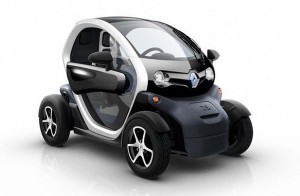

Specifications
Development status: Concept car
Year: 2013
Make: Renault
Model: Twizy
Passengers: 1 adult
0-60 time: 6 sec.
Top Speed: 68 mph
2013 Smart Fortwo Electric Drive Specifications
SPECIFICATIONS:
Production status: In production since 2009 (2nd generation model)
Year: 2013
Make: Smart
Model: Fortwo
Price: € 18910
Engine: 55 kW
0-60 time: 11.5 sec.
Top Speed: 78 mph (125.5km/h)
Passengers: 2 adults, side-by-side
Specifications for the Smart Fortwo in non-electric configurations:
Specifications from Wikipedia for 3rd generation Smart Fortwo electric engine:[3]
Power: peak power output of 55 kW (74 hp)[5][28]
Torque: 130 newton metres (96 lbf·ft)
Top speed of 125 km/h (78 mph)
0 to 100 km/h (0 to 60 mph) in 11.5[43] seconds and 0 to 60 km/h (0 to 37 mph) in 5 seconds
Battery capacity: 17.6 kW·h lithium-ion battery by Deutsche ACCUmotive[44]
Range: 145 km (90 mi)
Miles per gallon equivalent: 122 MPGe city, 93 MPGe highway, 107 MPGe combined[45]
Artificial warning sounds for pedestrians automatically activated in the U.S. and Japan, and manually activated in Europe.[46]
Kyburz eRod
Specifications (translated from the Kyburz website using Google Translate)
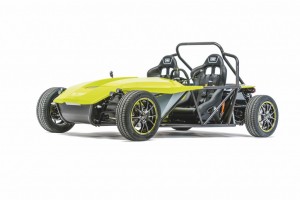
Weight: 570 kg (incl. Bat.)
Battery: 18 kWh, 100 V / 180 Ah
Power: 40 kW / 140 Nm
Range: 100 - 130 km
Drive: brushless AC motor on the rear axle
Braking recuperation: switchable
Helmet compulsory: No
Price: US$28,000 unassembled. US$38,000 assembled.
Comment: The eRod is almost twice the width and 25% longer than what I expect a future disruptive vehicle would look like. However, it does have the tubular frame I anticipate will be key and helps illustrate the sparseness of the underlying chassis that the 'future car' might have as its underpinning. Recall, Gordon Murray's 'iStream' car manufacturing methodology that seeks to scale the types of methods used in the manufacture of Formula 1 race cars. Note, the weight would need to be significantly reduced (to about 2/3rds or 400kg) - probably through super-strong composites. An enclosure for passengers is a given.
Specifications for Mini Cooper S
I used a Mini Cooper remote control car as a model for illustration purposes. The Mini Cooper S has very similar dimensions, and they are provided here for reference.
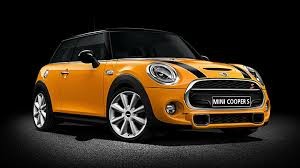
| Production |
2006–November 2013 (Hatch)2009–present (Convertible) |
| Assembly |
Plant Oxford, Cowley, England |
| Body and chassis |
| Class |
Supermini |
| Body style |
3-door hatchback2-door convertible |
| Layout |
FF layout |
| Related |
Mini Coupé, Mini Countryman, Mini Clubman |
| Powertrain |
| Engine |
1.4 L Prince I4 (One)1.6 L Prince/BMW N16 I4 (Cooper)1.6 L Prince turbo I4 (Cooper S)1.6 L Peugeot DV6 diesel I4 (Cooper D and One D)2.0 L BMW N47 diesel I4 (Cooper SD) |
| Transmission |
6-speed, automatic or manual |
| Dimensions |
| Wheelbase |
2,467 mm (97.1 in) |
| Length |
2007–2010: 3,698 mm (145.6 in)2007–2010 S: 3,713 mm (146.2 in)2011–2014: 3,729 mm (146.8 in) |
| Width |
1,684 mm (66.3 in) |
| Height |
1,407 mm (55.4 in) |
| Kerb weight |
1,150 kg (2,535 lb) (Cooper)1,210 kg (2,668 lb) (Cooper S) |
| Chronology |
| Predecessor |
Mini (R50/53) |
| Successor |
Mini (F56) |
Honda Accord dimensions: The Honda Accord is used as an example of a typical 'family sedan'.

| Dimensions |
| Wheelbase |
Sedan: 2,776 mm (109.3 in)Coupe: 2,725 mm (107.3 in) |
| Length |
Sedan: 4,862 mm (191.4 in)Coupe: 4,806 mm (189.2 in) |
| Width |
Sedan: 1,849 mm (72.8 in) |
| Height |
Sedan: 1,466 mm (57.7 in)Coupe: 1,435 mm (56.5 in) |
| Curb weight |
3,193 lb (1,448 kg) sedan[51] |
Calculations from Mini Cooper remote controlled car model
Actual Mini Cooper S dimensions: 3.7m long, 1.68m wide, 1.4m high.
Mini Cooper remote control car model dimensions: 200mm long.
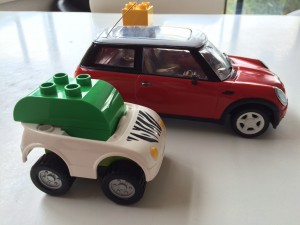
Calculation of scale ratio:
(Actual length) 3700mm to (Model length) 200mm = 37:2 = 18.6:1 ratio.
Therefore width converts to: 90mm
Therefore height converts to: 76mm
Hence, the speculated dimensions of ‘future car’ converted to 18.6:1 ratio are:
Unscaled dimensions of the Apple Car:
Length: Approx 1.5 to 1.6m
Width: Approx 1m
Height: Approx 1.5 to 1.6m.
Scaled dimensions of the Apple Car:
Approximate Length: 81-86mm
Approximate Width: 54mm
Approximate Height: 81-86mm (can be lower, but it means for a very reclined seating position, possibly requiring seat adjustment technology)
Apple Car Model Dimensions used in photographs:

Length: 96mm (1.79m)
Width: 58mm (1.08m)
Height: 72mm (1.34m)
[1] http://www.topspeed.com/cars/morgan/2016-morgan-ev3-ar172651.html#main
[2] http://www.topspeed.com/cars/renault/2013-renault-twizy-f1-concept-ar153883.html
[3] https://en.wikipedia.org/wiki/Smart_electric_drive#Third_generation
